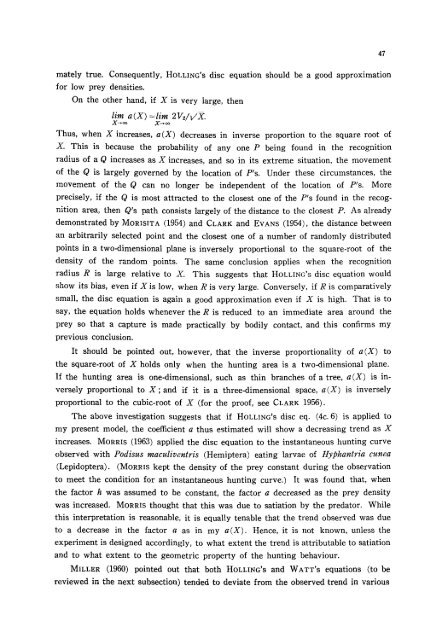A comparative study of models for predation and parasitism
A comparative study of models for predation and parasitism
A comparative study of models for predation and parasitism
Create successful ePaper yourself
Turn your PDF publications into a flip-book with our unique Google optimized e-Paper software.
47<br />
mately true. Consequently, HOLLING'S disc equation should be a good approximation<br />
<strong>for</strong> low prey densities.<br />
On the other h<strong>and</strong>, if X is very large, then<br />
lira a(X)=lim 2V~/v'X.<br />
X~o~ X~oo<br />
Thus, when X increases, a (X) decreases in inverse proportion to the square root <strong>of</strong><br />
X. This is because the probability <strong>of</strong> any one P being found in the recognition<br />
radius <strong>of</strong> a O increases as X increases, <strong>and</strong> so in its extreme situation, the movement<br />
<strong>of</strong> the Q is largely governed by the location <strong>of</strong> P's. Under these circumstances, the<br />
movement <strong>of</strong> the Q can no longer be independent <strong>of</strong> the location <strong>of</strong> P's. More<br />
precisely, if the Q is most attracted to the closest one <strong>of</strong> the P's found in the recog-<br />
nition area, then O's path consists largely <strong>of</strong> the distance to the closest P. As already<br />
demonstrated by MORISITA (1054) <strong>and</strong> CLARK <strong>and</strong> EVANS (1954), the distance between<br />
an arbitrarily selected point <strong>and</strong> the closest one <strong>of</strong> a number <strong>of</strong> r<strong>and</strong>omly distributed<br />
points in a two-dimensional plane is inversely proportional to the square-root <strong>of</strong> the<br />
density <strong>of</strong> the r<strong>and</strong>om points. The same conclusion applies when the recognition<br />
radius R is large relative to X. This suggests that HOLLING'S disc equation would<br />
show its bias, even if X is low, when R is very large. Conversely, if R is <strong>comparative</strong>ly<br />
small, the disc equation is again a good approximation even if X is high. That is to<br />
say, the equation holds whenever the R is reduced to an immediate area around the<br />
prey so that a capture is made practically by bodily contact, <strong>and</strong> this confirms my<br />
previous conclusion.<br />
It should be pointed out, however, that the inverse proportionality <strong>of</strong> a(X) to<br />
the square-root <strong>of</strong> X holds only when the hunting area is a two-dimensional plane.<br />
If the hunting area is one-dimensional, such as thin branches <strong>of</strong> a tree, a (X) is in-<br />
versely proportional to X;<strong>and</strong> if it is a three-dimensional space, a(X) is inversely<br />
proportional to the cubic-root <strong>of</strong> X (<strong>for</strong> the pro<strong>of</strong>, see CLARK 1956).<br />
The above investigation suggests that if HOLLING'S disc eq. (4c. 6) is applied to<br />
my present model, the coefficient a thus estimated will show a decreasing trend as X<br />
increases. MORRIS (1063) applied the disc equation to the instantaneous hunting curve<br />
observed with Podisus maculiventris (Hemiptera) eating larvae <strong>of</strong> Hyphantria cunea<br />
(Lepidoptera). (MORRIS kept the density <strong>of</strong> the prey constant during the observation<br />
to meet the condition <strong>for</strong> an instantaneous hunting curve.) It was found that, when<br />
the factor h was assumed to be constant, the factor a decreased as the prey density<br />
was increased. MORRIS thought that this was due to satiation by the predator. While<br />
this interpretation is reasonable, it is equally tenable that the trend observed was due<br />
to a decrease in the factor a as in my a(X). Hence, it is not known, unless the<br />
experiment is designed accordingly, to what extent the trend is attributable to satiation<br />
<strong>and</strong> to what extent to the geometric property <strong>of</strong> the hunting behaviour.<br />
MILLER (1960) pointed out that both HOLLING'S <strong>and</strong> WATT'S equations (to be<br />
reviewed in the next subsection) tended to deviate from the observed trend in various















